For those new to Indian cuisine, Masala Paratha is a traditional flatbread made from whole wheat flour, typically cooked on a hot griddle with a bit of oil or ghee. In this version—Masala Paratha—we elevate the basic paratha by adding a mix of aromatic spice powders directly into the dough, giving it a delicious burst of flavor in every bite.
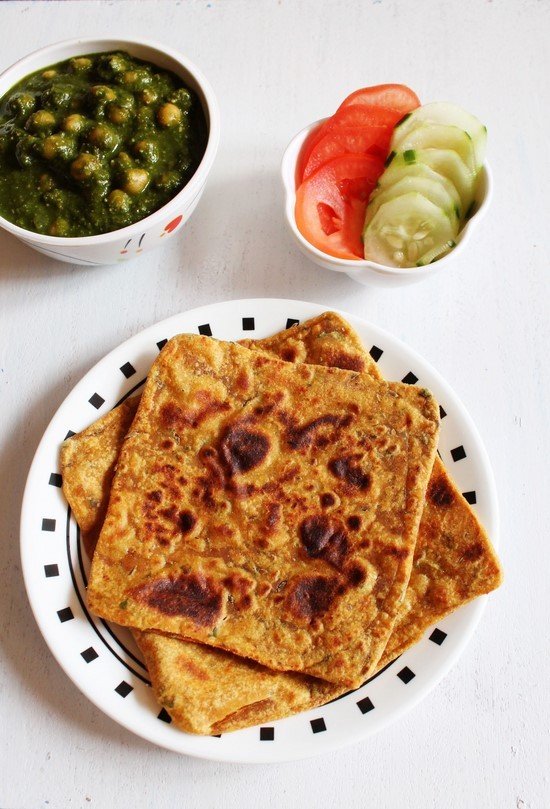
The shape of the paratha also affects its texture. While round parathas are quick and easy to roll, they may not turn out as flaky as the square or triangle ones. The layered folding process in those shapes, combined with a touch of oil, creates beautiful, crispy layers that make each bite more indulgent.
This particular recipe had been sitting in my drafts for a while. With a packed schedule over the last few days, I wasn’t able to finalize and post it. But as the weekend approaches, I’m finally carving out time to pursue my passion for food photography and recipe writing. I’m planning to test and capture a few dishes I’ve been experimenting with lately—so stay tuned for more!
Now, back to this flavor-packed masala paratha—it’s so tasty on its own that you can enjoy it with just some pickle or green chutney for a satisfying breakfast. My husband especially loves it with a steaming cup of masala chai in the morning.
I served it this time with Palak Chole, and it was a match made in heaven. Be sure to check out the full list of curries and gravies that pair beautifully with this spiced flatbread!
Ingredients For Masala Paratha:
- 1½ cups Whole Wheat Flour (Chapati Atta): This is the base of the dough. Use finely milled whole wheat flour, commonly used in Indian households for making rotis and parathas. It results in parathas that are tender with a gentle chew and offer a rich, hearty taste.
- 1 teaspoon Red Chili Powder: Adds a moderate level of heat and gives the paratha a slight reddish tint. Adjust the quantity to your spice preference.
- ½ teaspoon Turmeric Powder (Haldi): Turmeric adds a warm yellow hue to the dough along with a subtle, earthy undertone. It also adds a touch of warmth and is known for its health benefits.
- 1 teaspoon Garam Masala: A blend of warming Indian spices that adds depth, aroma, and complexity to the dough. It infuses every bite with classic Indian flavor.
- 1 teaspoon Coriander Powder: This spice adds a light citrusy and nutty flavor that complements the other spices well. It helps round out the flavor profile.
- 1 teaspoon Cumin Seeds (Jeera): Cumin seeds add a distinct earthy taste and a subtle crunch to the paratha. Lightly crush them before adding them if you prefer a milder flavor.
- ½ teaspoon Ajwain (Carom Seeds): Ajwain helps in digestion and adds a sharp, thyme-like aroma. Use sparingly, as it has a strong flavor.
- Salt – To Taste: Essential to enhance all the flavors in the dough.
- 2 tablespoons Oil (Plus Extra for Frying): A bit of oil is added to the dough for softness and to help create flaky layers. More is used during cooking for crispiness.
- ¼ cup Fresh Coriander Leaves (Cilantro), Finely Chopped: Adds freshness and a burst of flavor to the dough.
- ½ cup Water (Adjust as Needed): Used to knead the dough. Add the water slowly while mixing to form a smooth, pliable dough that isn’t overly sticky or too firm.
Step-by-Step Instructions:
1. Combine the Dry Ingredients:
In a large bowl, combine whole wheat flour with red chili powder, turmeric, coriander powder, garam masala, cumin seeds, ajwain, and salt. Stir everything together thoroughly so that the spices are evenly distributed throughout the flour.
2. Add Oil and Fresh Herbs:
Pour in 2 tablespoons of oil and add the finely chopped coriander (cilantro) leaves.
3. Rub the Mixture Together:
Using your fingertips, gently rub the oil and herbs into the spiced flour until the mixture becomes slightly crumbly in texture.
4. Knead the Dough:
Slowly add water as you mix, kneading the ingredients into a smooth and flexible dough. Aim for a dough that is soft and pliable—similar in texture to regular roti or plain paratha dough. Once kneaded, cover the dough with a damp cloth or plate and let it rest for 15 minutes.
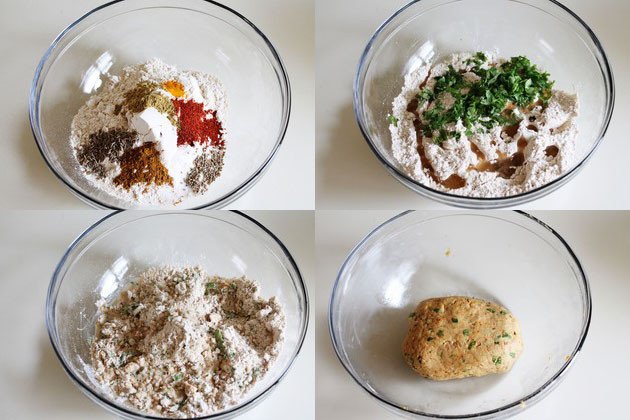
5. Divide and Preheat the Tawa:
After resting, knead the dough once more to make it smooth. Divide it into 9 equal portions, shaping each into a smooth ball and gently flattening it between your palms. At the same time, set a tawa or flat pan on medium heat to preheat.
6. Start Rolling:
Take one dough ball and roll it out into a 5-inch circle using a rolling pin and a little dry flour to prevent sticking.
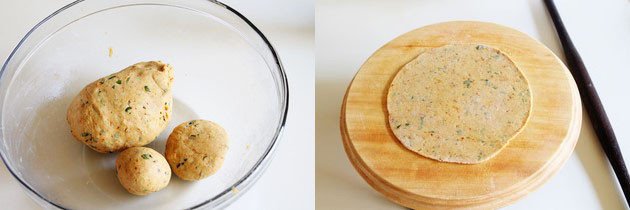
7. Add a Touch of Oil:
Lightly spread a thin layer of oil across the top of the rolled-out dough.
8–10. Fold into a Square:
Fold two opposite edges of the circle inward so they slightly overlap. Lightly oil again and fold the other two edges in the same way to form a square shape.
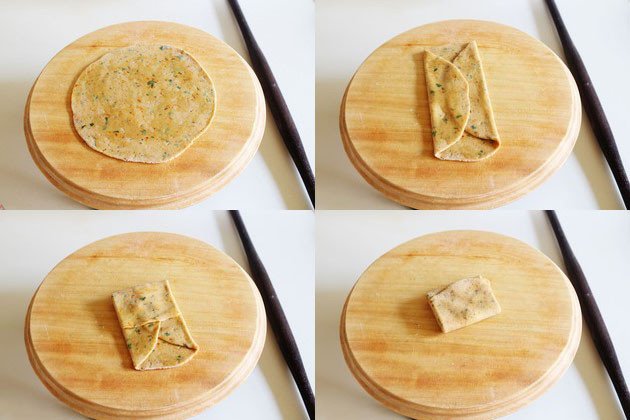
11. Dust and Roll Again:
Sprinkle a little dry flour over the square and roll it gently, maintaining the square shape as much as possible. Do not roll it too thin.
12. Cook the Paratha:
Place the rolled paratha onto the preheated tawa. When you start to see small bubbles forming, flip it over.
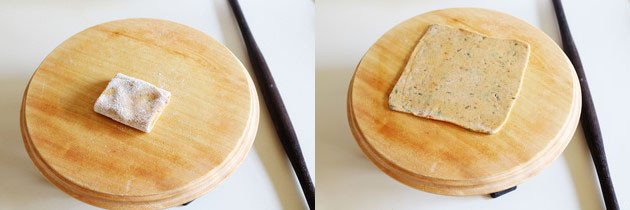
13. Apply Oil and Cook:
After flipping, apply a small amount of oil on the top side. Let it cook for a few more seconds.
14. Flip Again and Press:
Turn it over again and press lightly using a spatula, ensuring that it browns and cooks evenly on the underside.
15. Final Flip:
Drizzle a bit more oil on the surface and cook until both sides are evenly browned with golden spots.
16. Keep Warm & Repeat:
Once done, remove it from the skillet and place it in an insulated container or wrap it in a clean kitchen towel to keep it warm. Repeat the same process with the remaining dough portions until all your flaky, flavorful masala parathas are ready to serve.
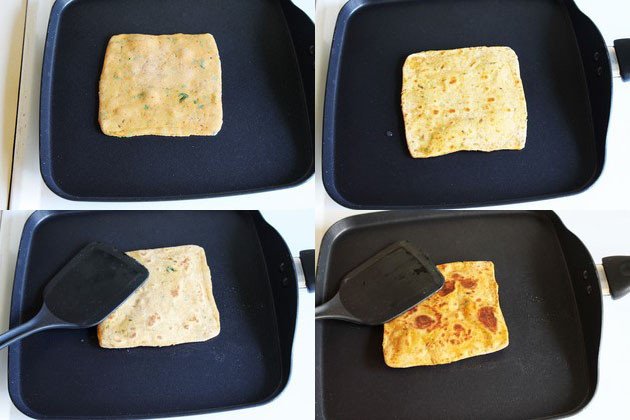
Expert Tips for Perfect Masala Paratha:
1. Choose Fresh and Aromatic Spices:
Use fresh, high-quality spices to maximize flavor. Spices like garam masala, coriander, and red chili powder lose their punch over time. For a deeper aroma, lightly toast cumin seeds and ajwain before adding them to the flour — it brings out their natural oils and enhances the flavor profile of the paratha.
2. Rest the Dough for Better Texture:
Allowing the dough to rest for 15–20 minutes is more than just a pause — it gives time for the gluten to develop, making the dough more elastic and easier to roll. It also helps absorb the moisture and spices evenly, leading to a softer, well-seasoned paratha.
3. Add Water in Stages:
Never pour all the water at once. Begin with small amounts and knead as you go. The amount of water needed can differ based on the type of flour used and the surrounding weather conditions. Aim for a dough that’s soft yet firm, not sticky or too loose.
4. Gentle Rolling Is Key:
Roll gently and evenly. Pressing too hard can tear the dough or flatten the layers, especially if you’re folding it into a square or triangle. Use minimal dry flour just to prevent sticking — too much can make the paratha dry and dense.
5. Cook on Medium Heat for Even Results:
Maintain a medium flame while cooking. A tawa that’s too hot can cause the paratha to brown too quickly while remaining undercooked inside. On the flip side, low heat can dry out the paratha, making it rubbery instead of soft and flaky.
6. Use Enough Oil for Crispiness:
Don’t skip brushing oil or ghee during cooking. It creates a beautifully crisp, golden crust while enhancing the overall flavor of the paratha.
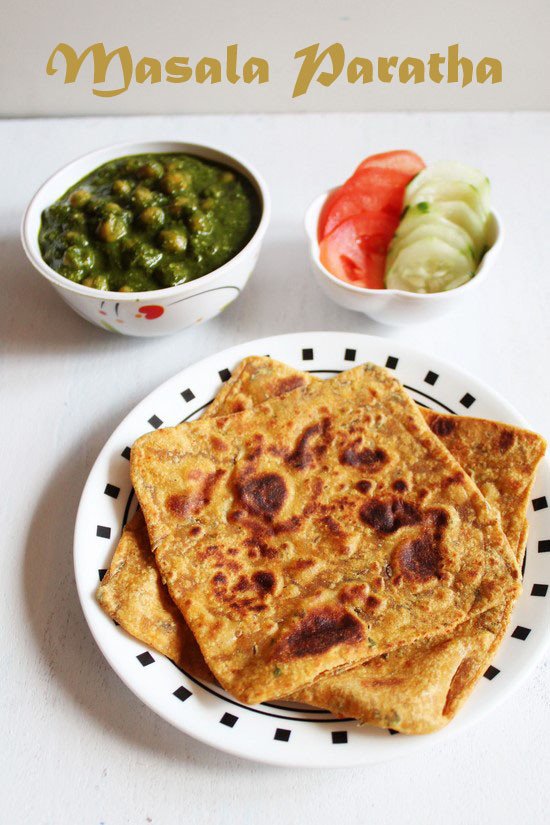
Serving Suggestions:
1. Breakfast Delight:
Start your morning with hot masala parathas, served fresh off the tawa with a dollop of homemade butter, a side of spicy green chutney, or tangy mango pickle. Pair it with a piping hot cup of masala chai for a flavorful and energizing breakfast. The blend of warm spices and crisp layers makes it the perfect morning comfort food.
2. Wholesome Lunch or Dinner:
Masala paratha makes a hearty addition to any main meal. Serve it with cool yogurt (dahi) or cucumber raita, along with a side of sabzi like aloo tamatar, palak chole, baingan bharta, or even rajma curry. Add a glass of buttermilk (chaas) to balance the spices for a complete North Indian-style thali.
3. School or Office Tiffin:
Masala parathas are easy to carry and stay flavorful even when cold, making them great for lunchboxes. Roll one up with grated cheese, paneer bhurji, or a smear of ketchup for a tasty, mess-free meal that kids and adults alike will love.
4. Weekend Brunch Special:
For a laid-back weekend brunch, pair masala paratha with boondi raita, sliced onion salad (pyaz lachha), and a side of lemon pickle. Add a cup of fresh juice or sweet lassi to turn it into a leisurely, satisfying spread.
5. Fusion Twist:
Transform leftover masala parathas into wraps by stuffing them with sautéed veggies, shredded chicken, or scrambled tofu for a fusion-style Frankie or roll.
6. Party Starter:
Cut the parathas into wedges and serve them with dips like mint yogurt or spiced hummus for a creative appetizer or snack platter.
